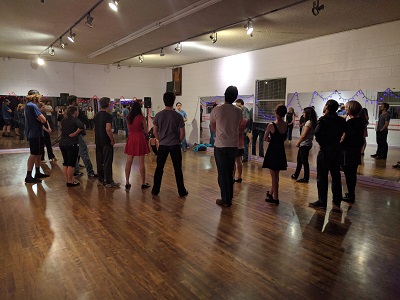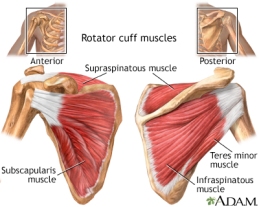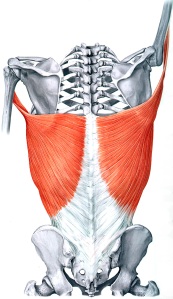Adventures in Assisting – UC 5.16 Week 7
The final week is done of my first Rolfing® training assist. It ended up being a big push to the end getting in as much as I outside of class while mostly wrapping up in the classroom. We wrapped up a day ago and I’m finding myself deeply grateful for the experience having learned a lot and set up a decent base for assisting again (in fact I’ve already got one loose offer to assist another instructor sometime in future). I’m also very grateful to friends, old and new, in the swing scene here who’ve helped me feel at home, and kept my nights busy with delicious food and equally delicious dancing.
Day 43 – September 26
 Monday came on fairly bright and early. The legendary Dawn Hampton had passed the night before and I was on and off Facebook through the morning checking out the tributes, stories, and videos of this incredible human.
Monday came on fairly bright and early. The legendary Dawn Hampton had passed the night before and I was on and off Facebook through the morning checking out the tributes, stories, and videos of this incredible human.
In class we spent the morning reflecting on our 10 series clients and what sort of results we had gotten with them. Watching the reflective process for the students was great particularly since I see the 10-series as being a strong self-teaching tool for Rolfers early on and throughout our careers. Session 9 with the 13-series clients followed with a little bit of a bittersweet feel moving towards the end of closure.
After class I caught a ride from Neal over to Heather Starsong‘s studio where I got a personal movement session. We worked a lot on spinal mechanics and getting my axial diaphgramatic structures relaxing and working together. It was a beautiful session and is probably going to be processing for a few months to come but I then got to have a 2 mile walk down to Kakes Studios for the Boulder Swing dance as a way to integrate. Had some great dances again with a nice tribute to Dawn then a couple of friends invited me over for Sazeracs and some chat time before taking me home probably later than was best for me to be out.
Day 44 – September 27
 Tuesday came on bright and early with a trip down to Snooze for breakfast then more 10-series presentations and my second demo session with my post-10 client. The afternoon rolled into mostly students trading sessions with each other which provided a nice break from holding space for outside clients and generally feels like we got a more relaxed energy and got to see the students interacting a bit more openly as practitioners.
Tuesday came on bright and early with a trip down to Snooze for breakfast then more 10-series presentations and my second demo session with my post-10 client. The afternoon rolled into mostly students trading sessions with each other which provided a nice break from holding space for outside clients and generally feels like we got a more relaxed energy and got to see the students interacting a bit more openly as practitioners.
Dancing this night took the form of a drive (or being driven) down to Denver for Joe Smith and the Spicy Pickles at a restaurant called Baur’s. The band was really damn good and it makes me wish we had the sort of infrastructure in Raleigh/Durham to support larger bands having weekly gigs like this. I got to meet and dance with a few new dancers I hadn’t run into yet and we headed home tired but satisfied.
Day 45 – September 28
 Wednesday night saw me up early for the last session of my 3-series trading with Neal. The session with Heather had given me a few ideas of spots to work on and Neal incorporated that info nicely into a nice wrap-up session for our work together.
Wednesday night saw me up early for the last session of my 3-series trading with Neal. The session with Heather had given me a few ideas of spots to work on and Neal incorporated that info nicely into a nice wrap-up session for our work together.
We spent the morning in class trading tips and tricks that we’d picked up along the way and watching Neal’s final session 10 demo. The student’s 10th sessions in the afternoon were again sort of bittersweet thought mostly sweet as the students closed out with these clients. I’m not sure if it was because they’d done movement as well or because it was closer to close or just luck of the draw but this round of closure felt more open and warm with gifts and cards exchanged and the like.
After class, Neal gave me a ride up to Skeye Brewing on his way home and stopped off to grab a beer with me before heading on. When we arrived, the beginner lesson for the dance that night was still going on and we got to talk a little bit of my philosophy for teaching dance. The crowd for the dance was on the smaller side but also nicely intimate and a lot of good dances (and a few brews) were had. I caught a ride home with one of the local teachers and had a really nice conversation about dance pedagogy before being dropped off at home and promptly crashing.
Day 46 – September 29
 By this point in the week it was beginning to feel like a rather intense, though worthwhile, haul through a lack of sleep. It wasn’t really intentional, just between the work with Heather and Neal I think we’d reached a sort of critical mass where some of the body shifts were interrupting my sleep for a bit.
By this point in the week it was beginning to feel like a rather intense, though worthwhile, haul through a lack of sleep. It wasn’t really intentional, just between the work with Heather and Neal I think we’d reached a sort of critical mass where some of the body shifts were interrupting my sleep for a bit.
Undeterred though we kept rolling on with class which was all about the final post-10 sessions today. My final session with my post-10 client came together really well and kind of made me wish I were closer. She asked if I had a card and I had to confess that I lived half a country away but would do my best to help put her in touch with someone who might be useful to her locally. Following class about half of us went over to Asher Brewing for a couple of beers and some conversation. Several of the students have family or significant others coming into town at this point so we got to talk a bit more about those folks and life beyond the classroom.
And reprising the start of my dancing during this course, some of the local decided to take another trip to Waterloo in Louisville for some Balboa dancing. The picture above is missing a good number of the new and old dance friends I’ve made here but I think it tells the spirit of this group well and I’m deeply grateful for the welcoming arms of the swing scene here.
Day 47 – September 30
 Graduation Day!
Graduation Day!
This was another early morning for myself and Neal as we had individual student evaluation interviews to do. Everyone passed with plenty of room and we got to talk with each student about their strengths, their challenges, and what we might recommend they pursue next in their development. Energies were higher overall than they had been in a while which I think is a testament to how much work goes into training as a Rolfer and how much of a relief it is to cross the finish line. The closing ceremony and graduation went great and then I crashed hard and just went to lie down on the floor a bit.
Following a reception at RISI, the class and families went out to Element Bistro for a drink. Neal and I hung around for an hour or so then headed to J&L Distilling for a final drink and debrief ourselves. When I had first booked my flights, Neal and I had planned this time thinking we’d need lots of time to talk out what had happened in the class but because we’d kept open lines of communication and feedback the whole time there really wasn’t much left unsaid and we spent the time instead talking about my heading to Boston and Neal’s upcoming trip to Peru.
Final night’s dancing in Colorado came courtesy of a gypsy jazz band called La Pompe playing at Brik on York which was a fancy pizza place in downtown Denver. A local dancer gave me a ride down and instead of pizza I ended up ordering a charcuterie plate that took most of the night to finish off. Had some great dances, especially in the second set when patrons started clearing out and we were able to move some tables and dance at the foot of the stage. One thing I’ve been noting a lot lately is how much of a difference it can make to dance with an audience around. At a standard swing dance everyone is kind of just doing their own thing, but at a restaurant or bar, dancing kind of makes us part of the entertainment and it’s been interesting to note how much that adds to the experience for me and kind of eggs on experimentation and play.
I got back home around midnight and tried to get to sleep fairly quickly for my flight the next morning.
Day 48 – October 1
 The last day in Boulder dawned a bit earlier than I would have liked, but with a 1pm flight to catch, an hour+ bus ride to get there, and the unpredictability of the lines at DEN, I decided it would be best to be up at out early. I had hoped to take my host to Snooze and to get myself a flight of fancy pancakes (still a brilliant idea) but by the time we arrived at 8:30 the wait was nearly an hour and would have been pushing it on my comfort zone with the time.
The last day in Boulder dawned a bit earlier than I would have liked, but with a 1pm flight to catch, an hour+ bus ride to get there, and the unpredictability of the lines at DEN, I decided it would be best to be up at out early. I had hoped to take my host to Snooze and to get myself a flight of fancy pancakes (still a brilliant idea) but by the time we arrived at 8:30 the wait was nearly an hour and would have been pushing it on my comfort zone with the time.
So instead I just hopped the bus to DEN, barely made weight on my bags stuffed with goodies from Colorado breweries and distilleries, and settled in to wing my way to Boston for Tinkerbal and seeing some dance and Rolfing friends I haven’t seen in quite some time. Today’s photo is from a little space in DEN above the trains in Terminal C that I’d just never noticed before, keeping a bit with this whole trip’s theme of noticing details and continuing to learn.
I landed in Boston around 9pm, caught an Uber to the dance that night and surprised the hell out of a few old and dear dance friends by being there. It was a lovely reception back and I wish I had gotten photos of the silly lobster dance contest, but I decided to just enjoy it rather than being a shutterbug. Staying the night with an old dance student of mine who lives near the venues and I slept in on Sunday longer than I have in a while.
Conclusion
It was a really wild ride getting to this point, having just completed my Advanced Training and getting asked to assist, working out how to make it fit with my current homeless state, and getting better insight both into how much I do actually know and how much there still is to learn in this work. I’m grateful to Neal for taking a chance with me and to all the students for their patience with both of our learning curves and for their presence and energy in class. And probably most importantly, a huge congratulations to AJ, Chris, Drew, Haley, Katie, Kyle, Monica, and Tiffani on making it all the way to being Certified Rolfers!!!

 This one seems simple and obvious, but it’s amazing sometimes how easy it is to forget. I see a lot of this as stemming from “I have to get the move right” style thinking with dancers, really at any level. Trying to forces moves or movements runs a high risk of doing something that doesn’t jive with yours or your partner’s body and worrying about making the move work or end a certain way lends itself to forcing it. Yes, it’s lovely to hit that 32 count sequence just the way you thought or simply finish a basic turn on time, but doing so at the expense of your body or your partner’s body kind of ruins the moment.
This one seems simple and obvious, but it’s amazing sometimes how easy it is to forget. I see a lot of this as stemming from “I have to get the move right” style thinking with dancers, really at any level. Trying to forces moves or movements runs a high risk of doing something that doesn’t jive with yours or your partner’s body and worrying about making the move work or end a certain way lends itself to forcing it. Yes, it’s lovely to hit that 32 count sequence just the way you thought or simply finish a basic turn on time, but doing so at the expense of your body or your partner’s body kind of ruins the moment. In the context of dance I think this mostly translates to “don’t assume you have the right to anyone’s body, time, or social interaction”. It’s easy and rather enticing to say things like “the boundaries are just different in dance” but I believe this often gets taken as “the rules of engagement around consent are different too”. The act of dancing with someone is just as much a negotiation as any other social interaction. The more it’s a balanced interaction where “no” is treated as a completely legitimate answer, the less likely this is to be an issue.
In the context of dance I think this mostly translates to “don’t assume you have the right to anyone’s body, time, or social interaction”. It’s easy and rather enticing to say things like “the boundaries are just different in dance” but I believe this often gets taken as “the rules of engagement around consent are different too”. The act of dancing with someone is just as much a negotiation as any other social interaction. The more it’s a balanced interaction where “no” is treated as a completely legitimate answer, the less likely this is to be an issue. This is probably the most pervasive but also the most subtle one and therefore easier to overlook; enough so that I spent most of a year saying the first two make it not suck aspects before I thought of this. As much as we love to talk about equality and togetherness in the dance scene, there can also be a lot of hierarchy at play, partly real partly in our own heads. When you set up a perceived power differential between lead and follow or experienced dancer and newbie it makes the dance more about roles and less about humanity. It also makes it much easier for things like
This is probably the most pervasive but also the most subtle one and therefore easier to overlook; enough so that I spent most of a year saying the first two make it not suck aspects before I thought of this. As much as we love to talk about equality and togetherness in the dance scene, there can also be a lot of hierarchy at play, partly real partly in our own heads. When you set up a perceived power differential between lead and follow or experienced dancer and newbie it makes the dance more about roles and less about humanity. It also makes it much easier for things like 













Written
on Mar 25, 2013